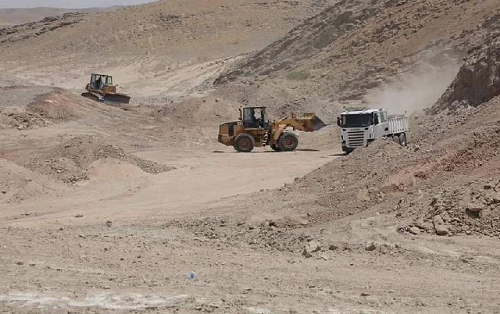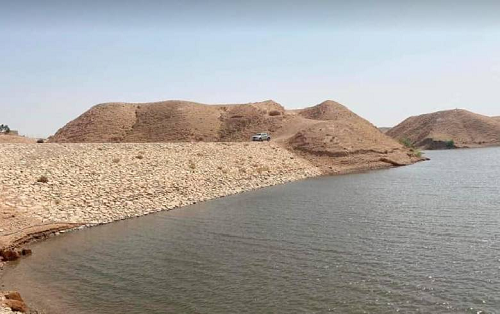Water management

The Iraqi government has subsidized the price of water for Iraqi customers, leading to overconsumption and waste by Iraqi citizens: Iraqis consume 392 litres per capita daily, while the international average is 200 litres per capita.
The widening gap between water supply and demand in Iraq is expected to increase from around 5 billion to 11 billion cubic meters by 2035.


Agriculture:


The entire structure of water management in Iraq was designed and constructed at a time when floods were a naturally occurring regular phenomena and water a plentiful resource. Annual flooding is what sustained agriculture in Iraq, this event washed away accumulated salts and deposited silt replenishing the vitality of the land.
Much of Iraq still relies on the same open-surface irrigation methods that have been employed since the Sumerian period. These irrigation networks have successfully been in use for millennia but are no longer workable in the face of repeated droughts. When the rains do arrive precious water is squandered along the route to the fields by both evaporation and leakage.
In some regions agricultural production methods have advanced towards more water efficient techniques such as plastic hoses, drip and spray heads, and hydroponic agricultural beds. However many farmers continue to use unsustainable and wasteful flood channel techniques instead of the more precise drip or sprinkler irrigation technology. One study published in 2021 found installing drip and sprinkler irrigation systems could save farmers about half of the water quantity used by existing traditional methods. The main benefit is delivering water to the exact point where it is needed.
The government should support the uptake of these methods with supplies of these products. They reduce the use of fertilizers and pesticides and with the addition of plastic sheeting to cover the soils also helps in reducing evaporation. Subsidising the cost of plastic hoses, drip and spray heads and hydroponic agricultural beds will significantly reduce the volume of water needs for many crops. Introducing more drought-tolerant seeds will also address some of the immediate needs.
The modernization of irrigation and water management could support the development of light industry to fabricate plastics and irrigation equipment, and the production plastic pellets needed as feedstock for this manufacturing.
In addition it is essential the government should switch the subsidies it currently provides to the agricultural sector away from purchasing produce at (highly elevated) fixed prices and redirect it to support that incentivises farmers to adapt their irrigation techniques. Alongside this there’s a huge opportunity to utilize renewable energy technologies such as solar and wind energy to power irrigation pumps.
 In order to address access to water and support crop production, traditional irrigation can still work in some districts but often the systems and pathways have been neglected and become inefficient and now require rehabilitation and improvement. These feeder channels should be evaluated to see where refurbishment and relining would be of benefit or enclosing in concrete pipework to reduce losses from evaporation and percolation. Farmers should be supported and encouraged to preserve productive lands in this way.
In order to address access to water and support crop production, traditional irrigation can still work in some districts but often the systems and pathways have been neglected and become inefficient and now require rehabilitation and improvement. These feeder channels should be evaluated to see where refurbishment and relining would be of benefit or enclosing in concrete pipework to reduce losses from evaporation and percolation. Farmers should be supported and encouraged to preserve productive lands in this way.
For Iraq to conserve water by modernising its irrigation systems The Ministry of Water Resources estimates this would cost the country between $50-70 billion over the next 13 years. To do this, a more unified national government approach in cooperation with empowered provincial authorities would be able to help local farmers throughout the country quickly transition to low-tech methods that reduce water usage.
By coming to an agreement with Turkey on the operational rules of certain dams, the use of man-made lakes that were created for flood control can cease allowing more water for Iraqi farmers and cities to use.
Iraq can work on domestic water governance. Push a bit harder on agricultural reforms, crop selection, irrigation technology, initiate climate change response plans, incorporate water scarcity as a priority component and allocate a sufficient national budget to address water scarcity. Water scarcity has arrived and will only continue to worsen unless urgent measures such as those outlined here are implemented. Water is used as though it were an endless ever-giving resource. A whole new-mind set now needs to be adopted at all levels that acknowledges water is a precious finite and dwindling resource that requires rigorous conservation.
Artificial recharging of groundwater:

Groundwater exists underground in saturated zones beneath the land surface. The upper surface of the saturated zone being known as the water table.
An effective way of conserving limited and or irregular rainfall is to harvest during the rainy season and utilise it to recharge groundwater reserves via new or existing boreholes. With extreme weather events including flooding becoming more frequent this can help balance out supply issues across the seasons by boosting the aquifers as a buffer against the dry season.
Runoff from heavy downpours – particularly across the man made environment where surfaces don’t allow for percolation – have been flooding residential areas and road networks leading to severe disruption and even death. This surplus water should be diverted towards purpose built reservoirs and then allowed to enter the aquifer through recharge wells in order to compensate for falling groundwater levels. Ideally these reservoirs should be both lined and covered to lessen the effects of evaporation and seepage.
GMS – ‘Groundwater Modelling System’ software can be used to produce a mathematical representation of groundwater permeation through to the aquifer and map the effectiveness of recharging and level of water tables.
Studies have proven directing surface water into the groundwater is an effective process and collecting ponds or reservoirs a successful means to achieve this. It is clearly a far better alternative than leaving it to spread and pool then simply be lost to evaporation.
Recharging groundwater with wastewater:


The utilization of treated wastewater is an important part of a water management planning strategy, particularly for the artificial recharge of groundwater resources and therefore agriculture in areas with scarce surface water. It further helps to compensate for a decline in natural recharge brought about by climate change.
Studies carried out near the Kerbala wastewater treatment plant (WWTP) is one of the first studies in Iraq on the application and sustainability of treated water and the process of artificial recharge.
This study focused on the Dibdibba aquifer located in central Iraq, between the cities of Najaf and Kerbala. The main objective was to accurately model an increase in groundwater levels and the range of the affected area as a result of applying artificial recharge via selected wells. The results indicate that the injection of treated water through 20 wells raised the water table in more than 91 and 136 km2 for 5,000 and 10,000 m3/day pumping rates, respectively. Moreover, increasing the volume of water added to the aquifer could lead to establishing new agricultural areas, spanning more than 62 km2, extending about 20 km along the river.
It proves this solution can be effectively deployed in proximity to urban areas with sewage treatment plants and excess rain water run off associated with built up areas where natural permeation is reduced.
Other regions in which artificial recharge techniques are successfully used include Iran, Tunisia, Morocco, and South Africa. The concept of artificial groundwater recharge technology is gaining momentum day by day because groundwater is such a variable and precious natural resource. Artificial recharge not only provides an efficient method of water storage allowing better management of the available resources, but it can also improve water quality indexes.
Creating artificial ponds:


 In areas with suitable topography where geological conditions permit, creating ponds and small dams is a practical method to protect against flooding while providing the opportunity to harvest and store rainwater for later use. This is particularly suited to the tributary hilly areas with ravines such as Kurdistan and the Western Desert / Jazeera area.
In areas with suitable topography where geological conditions permit, creating ponds and small dams is a practical method to protect against flooding while providing the opportunity to harvest and store rainwater for later use. This is particularly suited to the tributary hilly areas with ravines such as Kurdistan and the Western Desert / Jazeera area.
These bodies of water can assist in supporting local agricultural and livestock rearing opportunities. These reserves can additionally support further tree planting projects or to provide for horticultural projects such as growing fruit trees or vegetables in their vicinity. Each operation does its own small bit towards reducing desertification.

The Kurdistan Regional Government has acknowledged the benefit to both community and environment by embarking on a programme of pond and small dam building for some years. 118 Ponds have been constructed in the Kurdistan Region so far, reportedly on an area of nearly half a million acres, holding over 22 million cubic meters of water at a cost approaching 29 billion dinars.
This stored surface water resource, that may have otherwise be lost to evaporation, can also be diverted to the aquifer using groundwater recharging methods doubling the effectiveness of such programmes in both storage and flood control.
Apart from the immediate practical benefits the ponds encourage wildlife and enhance the geographical beauty of the region boosting tourism and employment opportunities.


